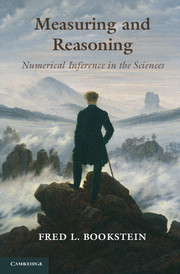Book contents
- Frontmatter
- Dedication
- Contents
- Analytical Table of Contents
- Preface
- Epigraphs
- Part I The Basic Structure of Numerical Inference
- 1 Getting Started
- 2 Consilience as a Rhetorical strategy
- 3 Abduction and Strong Inference
- Part II A Sampler of Strategies
- Part III Numerical Inference for General Systems
- Part IV What Is to Be Done?
- References
- Index
- Plate section
2 - Consilience as a Rhetorical strategy
from Part I - The Basic Structure of Numerical Inference
Published online by Cambridge University Press: 05 March 2014
- Frontmatter
- Dedication
- Contents
- Analytical Table of Contents
- Preface
- Epigraphs
- Part I The Basic Structure of Numerical Inference
- 1 Getting Started
- 2 Consilience as a Rhetorical strategy
- 3 Abduction and Strong Inference
- Part II A Sampler of Strategies
- Part III Numerical Inference for General Systems
- Part IV What Is to Be Done?
- References
- Index
- Plate section
Summary
The Scorpion story in Chapter 1 was technoscience journalism – a poignant historical anecdote that conveys one essential aspect of the way quantitative reasoning is used all across the sciences that use it. In this chapter we get down to the serious business of scientific methodology by retelling a similar story that arose in quite a different context: geophysics. Establishing the theory of continental drift as fact was inseparable from the discovery of seafloor spreading, the mechanism that provides the explanation for drift, and the connection of the mechanism to the pattern it accounts for is strictly quantitative. Many books are available regarding this now firmly established theory, including several on its intellectual history. This chapter begins by revisiting the core of the scientific inference in terms of consilience, the topic of this chapter, along with abduction, the topic of the next one.
William Whewell seems to have brought the word “consilience” into philosophy of science in 1840, noting, “The Consilience of Inductions takes place when an Induction, obtained from one class of facts, coincides with an Induction obtained from another different class. Thus Consilience is a test of the truth of the Theory in which it occurs.” In its full generality like this the concept may seem forbiddingly subjective, slippery, even mystical. A lecturer like me would do well to begin instead with an example as accessible as the Scorpion story but dealing with a scientific topic rather than a discrete episode of military misfortune.
- Type
- Chapter
- Information
- Measuring and ReasoningNumerical Inference in the Sciences, pp. 17 - 72Publisher: Cambridge University PressPrint publication year: 2014



